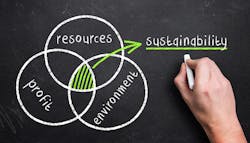Competing priorities, multiple perspectives slow sustainability progress
On the surface, sustainability as an issue seems simple enough. Many within the healthcare industry acknowledge, recognize and understand the ideas behind conservation, eco-friendly, environmentally responsible and safe or even “green.”
Further, sustainability as a functional strategy and tactic generally can be organized into four key categories:
- Conserving/reducing energy and resource consumption (including air, electricity and water)
- Reducing material waste (e.g., disposal of unused new products or pre-consumer waste and used products or post-consumer waste, etc.)
- Reducing chemicals/elements/materials of concern in the manufacturing process (e.g., carbon, PVC, DEHP, etc.)
- Contracting for/investing in sustainably designed and manufactured products – essentially the next step after the previous three.
Two major factors appear to pose challenges to sustainability’s progress toward acceptance, adoption and implementation by even a slight majority of healthcare organizations.
- Sustainability subject matter experts (SMEs) who are corporate executives at some of the leading companies in the healthcare industry have yet to agree on the priority of sustainability initiatives worth promoting and pursuing
- And these same experts offer a diversity of reasons for why healthcare organizations have been slow to respond to a set of changes widely regarded as “the right thing to do.”
Although none of the interviewed corporate executives agree on which sustainability projects to make higher priority or why senior healthcare leaders hesitate to support it, none essentially is wrong in his or her perceptions and understanding of human behavior.
Healthcare Purchasing News conducted a brief survey of six prominent sustainability SMEs from manufacturers, distributors and group purchasing organizations (GPOs). Each responded to four questions. In two of the questions, all six varied their responses across the board. In one, the majority coalesced around a central premise. In the last, they were split down the middle.
HPN asked the sustainability experts to rank the four categories in terms of priority for Supply Chain or any department or individual to address.
Five of the six selected different leading priorities and one changed the definitions of the categories, regrouping three under one category and introducing several others as meaningful to the organization and its customers.
“The American healthcare system is a huge contributor of environmental waste, with recent estimates exceeding 10 billion pounds per year, or 29 pounds of waste per bed per day, according to PracticeGreenhealth.org,” Lewis said. “Much of this waste comes from single-use items made of plastic and polymer materials and ends up in our landfills. The half-life on this type of material ranges from 40 years to 500 years, depending on many production and sourcing variables, according to WWF Australia. This current status quo model of heavy disposable, single-use products advocated by healthcare executives, supply chain managers, GPOs and suppliers is unsustainable and irresponsible. There are better, less damaging options available, particularly in the protective equipment sector. Reusable protective equipment has been proven to be more effective, safer, easier to use and significantly less costly. In addition, it reduces the disposal of rate of medical waste by [around] 700%.”
Lewis points next to contracting for and investing in sustainably designed and manufactured products. He attributes the reliance on single-use products to ignorance and simple economics.
“They just don’t know any better because this is the way it has always been done or at least the way it has been done since the advent of cheap, readily available plastic/polymer materials,” he observed. “The availability of these materials contributed to the shift of manufacturing to overseas, which compounded the problems and included little oversight available from U.S. companies. Cost became the main reason to purchase.”
“All four areas are important and each one contributes to a significant stride in achieving a sustainable operation,” Olivier contended. “As a healthcare manufacturer and distributor, Medline is committed to leveraging our healthcare sustainability expertise to help customers contract for sustainably designed and manufactured products.”
Olivier acknowledges, however, that from a healthcare provider’s perspective, reducing material waste and conserving energy and resource consumption are “where supply chain departments often see more immediate cost savings,” she added.
“These are all critical and should be included in any serious look at sustainable initiatives,” Chase admitted. “The importance ranking is listed by ease, as the latest UN IPCC (Intergovernmental Panel on Climate Change) report has accelerated the dates for long-term meaningful action. And that action needs to start today! Each initiative has a timeline and cost, as well as long-term meaningful impact investment. But the key is to start today, and with what is available to us. There are companies like ours that accomplish [the first three] with in our product design.”
“It’s difficult to produce a ranking of sustainability priorities today as the urgency of the moment in which we’re living truly cries out for an ‘all of the above’ strategy,” he noted. “However, with the net-zero clock ticking ever louder, any action that reduces the production of greenhouse gasses might be considered highest priority.
“Reducing electricity and natural gas consumption has direct, meaningful and quantifiable benefits,” Knox continued. “This holds equally true for water conservation, particularly in water stressed regions of the country. Both waste material reduction and contracting for sustainably designed materials in healthcare promote environmental stewardship and sustainability in the sector overall, while eliminating chemicals of concern is at the heart of healthcare’s healing mission.”
“Contracting for and investing in environmentally preferred products is the most important priority among the four as it ensures the purchase of the safest products for the environment and for human health,” Indivieri insisted. “Products with a reduced environmental footprint have been manufactured with consideration for all stages of a product’s life cycle. A sustainably designed product encompasses all the above priorities and then some: Its raw materials are renewable, recycled and responsibly sourced; it does not contain chemicals of concern that can cause risk to patients; it can be used longer than alternatives and can be reprocessed and diverted from the landfill; and it is locally or regionally made, consuming fewer resources while being less dependent on fossil fuels for transportation. All of these sustainable procurement tenets ensure patients’ healing with no adverse health effects transpiring.”
Indivieri homes in on N95 masks in high demand during the global pandemic for their infection prevention properties as a noteworthy example.
“Unfortunately, the lifecycle of disposable N95 masks is far from sustainable,” she indicated.
Indivieri cites five reasons why N95 masks can be challenging sustainably.
- Raw materials: “Plastics for N95 masks are made from fossil fuels that can be mixed with chemicals of concern,” she said.
- Manufacturing: “N95 masks that are made overseas may include heating plastic fibers that release toxic fumes.”
- Transportation: “This form of PPE can be transported across the world by various forms of shipping and ground transportation, adding fossil fuels into the environmental equation.”
- Use: “A single N95 mask is used once per each care episode.”
- Disposal: “They’re disposed of in the landfill and take hundreds of years to degrade.”
Supply chains cause most greenhouse gas emissions, 80% across the world to be exact, and human health suffers because of it, according to Indivieri. She cites research from Health Affairs that states in 2013, negative health impacts produced from healthcare pollution were comparable to deaths from preventable medical errors. “Scope 3 greenhouse gas emissions, defined by the EPA as those that are the result of activities from assets not owned or controlled by the reporting organization, such as product transport, employee travel and commuting, account for approximately four-fifths of the total greenhouse gas emissions from the healthcare sector in the United States,” she said.
Consequently, setting priorities for sustainable projects can be based on numerous factors, including:
- Geography and environmental challenges associated with a facility’s location
- Community socio-economic factors
- Community/culture
- State/local regulatory requirements
- Organizational budgetary goals
- Environmental/health concerns
“Ranking depends on the purchasing organization’s priorities/goals and on the type of product under consideration,” Starr said. “For example, if a healthcare organization has a goal to reduce greenhouse gas emissions, they may prioritize the first one. If they are buying a product that has patient contact, such as IV bags and tubes, they may prioritize chemicals of concern. The social criteria focus on people, and if you are buying a product where forced labor has been a persistent issue, this criterion may weigh more.”
Determining social and economic sustainability issues may fall outside of Supply Chain’s traditional purview, but that doesn’t make the two pillars any less important, according to Starr.
“For our organizations, social is focused on health and well-being of people and ensuring the basic human rights in their employment, such as equal opportunity, fair wages, using diverse suppliers, and safe working conditions,” she said. “One might need to [recognize] ‘social determinants of health’ to be fully understood.
“Economic is focused on using economic power for the good of all society, such as buying local, cost savings, looking at the total cost of ownership,” Starr continued. “This approach can make the work seem daunting, but the key is to establish a plan, priorities and start the work. The more complex issues can be tackled with progress and experience with success.”
Must a healthcare organization have someone on staff researching social criteria to ferret out forced labor? Not necessarily, Starr notes.
“At Health Care Without Harm, Practice Greenhealth and Greenhealth Excchange (GX) there is a strong emphasis on the issues that can impact climate change, which covers a host of areas for focus, but also significantly affect human health,” she said. As for how to determine if forced labor is an issue, Supply Chain professionals should stay informed on the supply categories that have a pattern of using forced labor, such as gloves and textiles, but also just being aware of where products are made can help narrow the areas of risk. There are non-profits such as HCWH that are researching and addressing these issues and government agencies that report information on forced labor. Like with any other market change, the customers’ collective voice can impact this issue.”
Sensible starts
If Supply Chain were asked to choose one of the four key categories that make the most sense to start sustainability projects, four of the six sustainability experts agree on one area: Contracting for and investing in sustainably designed and manufactured products.
“Although we firmly believe that reducing material waste is the single most important item to address, it is essentially an outcome or a result. It is not an action item,” Benko Medical’s Lewis noted.
“The most effective way to accomplish reducing material waste is by contracting and Investing in sustainably designed and manufactured products,” he agreed. “This requires a paradigm shift in thinking. It will disrupt the status quo. There are companies out there, like Benko Medical, who are seeking solutions for healthcare and are ready to deliver on a larger scale to American hospitals and facilities.”
Contracting contains a framework, according to Medline’s Olivier.
“Many of these areas require the sustainability team within an organization to embark on their own adventure and create a strategy, but there’s already criteria in place to help health systems contract for sustainably designed products,” she said. “Organizations such as Practice Greenhealth offer environmental purchasing specifications and guides to help health systems ask suppliers the right environmental questions about products, explanations of environmental issues around products and referrals to product lists.”
Contracting for and investing in sustainable products is where healthcare can make the most difference and lead the way, argued NewGen Surgical’s Chase.
“The timeline for global decarbonization mandates that developed countries achieve 45% reduction in CO2 by 2030,” she noted. “As a major contributor to global carbon emissions and global economies, and as the industry dedicated to human wellbeing, the healthcare sector should lead by example and solutions. The industry must rapidly endorse science-based targets and adopt low-carbon products, processes and services. The clinical device market is rich with opportunities to reduce carbon emissions and align products with the goals of healthcare.
Chase cites data from Health Care Without Harm’s Global Roadmap to Decarbonization on how implementing circular healthcare and sustainable waste management can reduce a cumulative 4.8 Gt of CO2e by 2050. “The circular economy [comprises] two unique cycles that maximize the utility of each product input along its entire lifecycle,” Chase said. “The technical cycle maintains products made from extractive inputs such as metals and plastics through maintenance, reuse, refurbishment and then recycling. Complementary to the technical cycle is the biological cycle, which metabolizes biological materials as product inputs, natural energy sources, biochemical extracts and then soil nutrients. The World Economic Forum recommends redesign as a leading sustainable idea. Products can address reducing plastic, chemicals of concern and carbon using circular design principles,” she added.
Vizient’s Indivieri acknowledges the vastness of sustainability’s reach.
“Sustainability can be overwhelming,” she admitted. “It touches everything in a healthcare organization – from anesthesia given to patients, to food that provides healing nutrition, to care givers and family members who spend time in the healthcare setting. Rather than focus on one theme, all should be taken into account when contracting for sustainably designed products.
Indivieri advocates for an organization-wide environmentally preferred purchasing policy that outlines key priorities as a smart place to start. It’s simple economics or business.
“Environmentally preferred purchasing criteria can be used to signal to suppliers that environmentally preferred products and services are a priority and will therefore earn more business,” she insisted. “In short, going green equates to making green for vendors and distributors. Everyone wants to do the right thing, but revenue and profit will absolutely motivate businesses to move swiftly.”
But she spots demand shifts already.
“Many GPOs in the healthcare industry are requesting environmentally preferred information from suppliers and are sharing it with their members to ensure transparent purchasing,” she said. “What’s needed is to go a step beyond and implement environmentally preferred contract language for medical/surgical and physician preference items. GPOs must ask suppliers to provide safer alternatives when environmentally preferred product attributes are not met and request that suppliers provide a plan to eliminate chemicals of concern or hazardous waste. Instead of simply encouraging sustainable procurement, GPOs should partner with their suppliers to ensure the health care market makes lasting changes to encourage human health and combat the negative effects of carbon emissions.”
Premier’s Knox still favors reducing energy and resource consumption.
“Reducing energy and resource consumption is a logical place to start because it has the potential to generate both quantifiable and meaningful cash and carbon savings,” he said. “Many organizations use this data as a foundation upon which to launch other, perhaps more challenging, sustainability initiatives. Reducing material waste by reprocessing medical devices, and ensuring supplies do not expire before utilization, can also generate similar data. Starting with these types of initiatives to generate excitement and momentum for a broader sustainability program can be a useful approach, especially early on.”
Finding direction depends on an organization’s goals, according to GX’s Starr.
“Generally, sustainability looks at ensuring patient and environmental health,” she observed. “The important thing is to do the planning work so that the priorities selected reflect the organization’s larger goals and strategies. This will aid efforts as the work moves forward.”
Rather than ignore the issue of modern-day slavery, human trafficking and forced labor, healthcare organizations should pay attention to it because of risk, Starr insists.
“There is risk organizationally, legally, reputational, etc., if an organization has been buying goods produced by child or forced labor,” she said. “One health system is training physicians and clinicians to be aware of patients who might be subject to these conditions and opportunities they have to recognize and address. This also addresses basic human rights of people and healthy working conditions.”
Booking ROI
Half of the corporate sustainability executives surveyed anticipate the healthiest potential return on investment in one area: Contracting and investing in sustainably designed and manufactured products.
For Benko’s Lewis, it begins at the top.
“Everything starts with the decision makers, the executives, the shareholders, etc.,” Lewis insisted. “If there is no push to decrease waste from the top, very little can be accomplished from below, no matter the level of passion that is put behind it. Independent of high-level approval, a great idea will most likely die with the idealist. Healthcare organization leaders must lead the charge of reducing their impact. By contracting with, and investing in American producers of reusable items, they will act as advocates for a cleaner environment, and people will follow.”
The contracting aspect represents working smarter, not harder because all the responsible elements already are in place at that point, according to Vizient’s Indivieri.
“Sustainably designed products utilize renewable resources, are made from recycled content and are responsibly sourced,” she said. “These products are safer for our patients, their family members and our care givers because they do not contain chemicals of concern. They are free of bisphenols that are endocrine disruptors, reproductive toxins, developmental toxins and heavy metals, which are carcinogens. Their product life is longer than usual because they can be cleaned, maintained and repaired. They can be reprocessed and diverted from landfills because they are reusable, recyclable, do not generate hazardous waste and do not generate waste when delivered. They are locally sourced, meaning that they reduce transport miles, contribute to a sustainable economy and support local job creation. They consume fewer resources because they are resource efficient. Last, but certainly not least, they curb carbon emissions because they are less dependent on fossil fuels.”
NewGen Surgical’s Chase concurs.
“Climate-smart design in products addresses all sustainable goals and are immediately available for measurable, meaningful environmental results in the supply chain,” she added.
Others aren’t quite so deliberate as decisions and outcomes will vary by organization.
“The starting point will depend on the organization’s current environmental impact and their priorities moving forward,” said Medline’s Olivier. “For example, a pediatric department may have more concern over reducing chemicals of concern in the manufacturing process because it can impact the health of children from a young age. A laundry department may prioritize conserving energy because they use a lot of electricity, making energy conservation an element of sustainability where it can have the greatest impact.”
Much depends entirely on a health system’s individual aims and aspirations, according to Premier’s Knox.
“The first two options (conserving/reducing energy and resources and reducing material waste) have the potential to produce measurable and meaningful results more immediately, while the other two options (reducing chemicals/elements/materials of concern and contracting/investing) are currently more difficult to quantify,” he said. “Eliminating chemicals of concern, for instance, is a worthy objective, but it can be very difficult for an individual hospital system to quantify the impacts of those measures.”
Participation in sustainability projects and achieving measurable results with “low-hanging fruit” initiatives can drive interest, according to GX’s Starr.
“If you’ve done no work in waste, then there are areas for recycling and using reusable products,” she said. “In energy, if nothing has been done, just look for ‘Energy Star’ electronics. If chemicals, look at plastics with toxic chemicals used in the NICU [with the] most vulnerable patients.”
About the Author
Rick Dana Barlow
Senior Editor
Rick Dana Barlow is Senior Editor for Healthcare Purchasing News, an Endeavor Business Media publication. He can be reached at [email protected].







